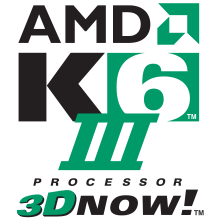This article has multiple issues. Please help improve it or discuss these issues on the talk page. (Learn how and when to remove these messages)
|
 | |
| General information | |
|---|---|
| Launched | February 22, 1999 |
| Discontinued | End of 2003[1] |
| Common manufacturer | |
| Performance | |
| Max. CPU clock rate | 333 MHz to 550 MHz |
| FSB speeds | 66 MHz to 100 MHz |
| Architecture and classification | |
| Technology node | 0.25μm to 0.18μm |
| Microarchitecture | K6 |
| Instruction set | x86 |
| Extensions | |
| Physical specifications | |
| Cores |
|
| Sockets | |
| Products, models, variants | |
| Core name |
|
| History | |
| Predecessor | K6-2 |
| Successor | Athlon |
The K6-III (code name: "Sharptooth") was an x86 microprocessor line manufactured by AMD that launched on February 22, 1999. The launch consisted of both 400 and 450 MHz models and was based on the preceding K6-2 architecture. Its improved 256 KB on-chip L2 cache gave it significant improvements in system performance over its predecessor the K6-2. The K6-III was the last processor officially released for desktop Socket 7 systems, however later mobile K6-III+ and K6-2+ processors could be run unofficially in certain socket 7 motherboards if an updated BIOS was made available for a given board. The Pentium III processor from Intel launched 6 days later.
At its release, the fastest available desktop processor from Intel was the Pentium II 450 MHz, and in integer application benchmarks a 400 MHz K6-III was able to beat it as the fastest processor available for business applications.[2] Just days later on February 26 Intel released the Pentium III "Katmai" line at speeds of 500 MHz, slightly faster than the K6-III 450 MHz.
Intel retained the lead in 3D gaming performance. Many popular first person games at the time were specifically tuned to extract maximum performance from Intel's pipelined floating point unit in drawing their 3D environments. Since the K6-III inherits the same floating point unit as the K6-2 (low latency but not pipelined), unless the game was updated to use AMD's 3D-Now! SIMD instructions - performance could still remain significantly lower than when run on Intel.